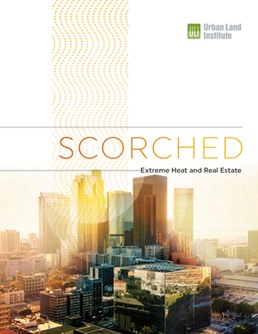Scorched: Extreme Heat and Real Estate

Extreme heat is the most widespread and deadly weather-related hazard in the United States, and it is worsening due to both climate change and urban development patterns. It is a complex problem that has significant impacts on human health, and the built environment offers numerous opportunities for mitigation. Scorched: Extreme Heat and Real Estate outlines how extreme heat will affect the real estate and land use sectors and highlights the leadership and the potential positive impact of the real estate sector in implementing “heat-resilient” building designs and land uses.
The report provides an overview of extreme heat’s connections to the built environment and an in-depth discussion of heat mitigation and adaptation strategies related to building design, building materials, green infrastructure and public space design. These strategies can “future-proof” real estate in vulnerable markets; lower operations and management costs; improve tenant and occupant experience; and otherwise differentiate a real estate project. Through a series of real estate development and land use policy case studies, the report explores how U.S. real estate developers, designers, and policymakers are implementing solutions to make spaces more adaptable to environmental conditions and comfortable for occupants.
Book Summary: Extreme heat is the most widespread and deadly weather-related hazard in the United States, and it is worsening due to both climate change and urban development patterns. It is a complex problem that has significant impacts on human health, and the built environment offers numerous opportunities for mitigation. Scorched: Extreme Heat and Real Estate outlines how extreme heat will affect the real estate and land use sectors and highlights the leadership and the potential positive impact of the real estate sector in implementing “heat-resilient” building designs and land uses.
The report provides an overview of extreme heat’s connections to the built environment and an in-depth discussion of heat mitigation and adaptation strategies related to building design, building materials, green infrastructure and public space design. These strategies can “future-proof” real estate in vulnerable markets; lower operations and management costs; improve tenant and occupant experience; and otherwise differentiate a real estate project. Through a series of real estate development and land use policy case studies, the report explores how U.S. real estate developers, designers, and policymakers are implementing solutions to make spaces more adaptable to environmental conditions and comfortable for occupants.


